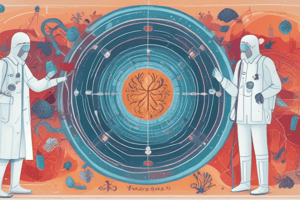Podcast
Questions and Answers
What is the primary cause of infectious diseases?
What is the primary cause of infectious diseases?
The presence of pathogens such as bacteria, viruses, fungi, or parasites in the body
Name four types of infectious diseases.
Name four types of infectious diseases.
Bacterial, Viral, Fungal, and Parasitic infections
What is the primary mode of transmission for airborne diseases?
What is the primary mode of transmission for airborne diseases?
Coughing and sneezing
What is a major factor influencing the spread of infectious diseases?
What is a major factor influencing the spread of infectious diseases?
What is the primary method of preventing the spread of infectious diseases?
What is the primary method of preventing the spread of infectious diseases?
What is the importance of handwashing in preventing the spread of infectious diseases?
What is the importance of handwashing in preventing the spread of infectious diseases?
Name three vaccine-preventable diseases.
Name three vaccine-preventable diseases.
What is the importance of quarantine and isolation in controlling outbreaks?
What is the importance of quarantine and isolation in controlling outbreaks?
What is the benefit of vaccination beyond individual protection?
What is the benefit of vaccination beyond individual protection?
Flashcards are hidden until you start studying
Study Notes
Infectious Diseases
Definition and Types
- Infectious diseases: illnesses caused by the presence of pathogens such as bacteria, viruses, fungi, or parasites in the body
- Types:
- Bacterial infections (e.g., tuberculosis, pneumonia)
- Viral infections (e.g., influenza, HIV)
- Fungal infections (e.g., candidiasis, ringworm)
- Parasitic infections (e.g., malaria, tapeworm)
Transmission and Spread
- Modes of transmission:
- Direct contact (e.g., touching, kissing)
- Indirect contact (e.g., contaminated surfaces, food, water)
- Airborne transmission (e.g., coughing, sneezing)
- Vector-borne transmission (e.g., mosquitoes, ticks)
- Factors influencing spread:
- Poor hygiene and sanitation
- Lack of vaccination
- Weakened immune system
- Global travel and commerce
Prevention and Control
- Methods:
- Vaccination
- Improved hygiene and sanitation
- Use of personal protective equipment (PPE)
- Vector control (e.g., insecticides, mosquito nets)
- Quarantine and isolation
- Importance of:
- Handwashing
- Proper food handling and storage
- Avoiding close contact with infected individuals
Vaccine-Preventable Diseases
- Examples:
- Measles, mumps, and rubella (MMR)
- Influenza (flu)
- Hepatitis A and B
- Human papillomavirus (HPV)
- Pertussis (whooping cough)
- Importance of vaccination:
- Reduces disease incidence and transmission
- Protects vulnerable populations (e.g., young children, elderly)
- Helps prevent outbreaks and epidemics
Studying That Suits You
Use AI to generate personalized quizzes and flashcards to suit your learning preferences.




